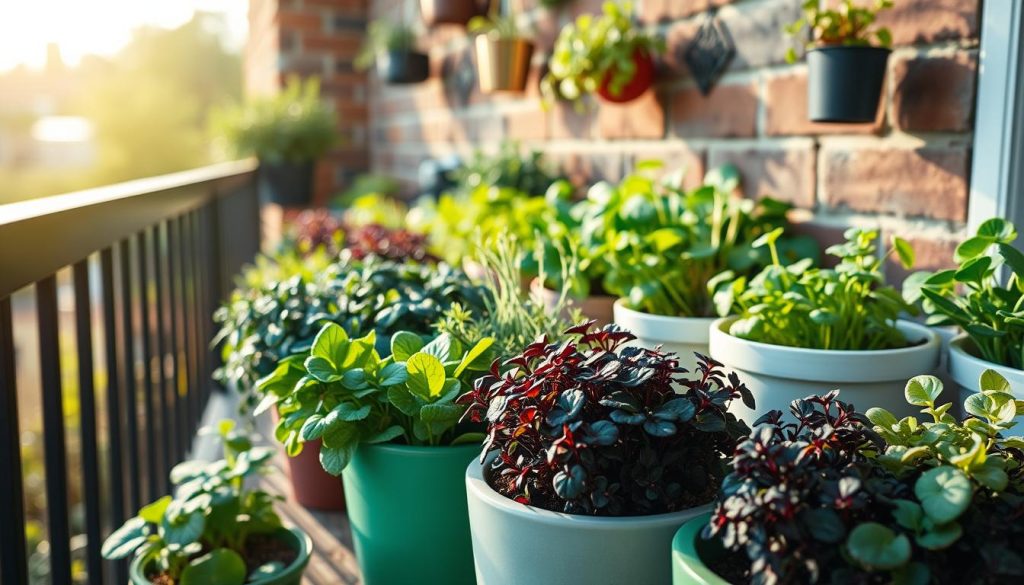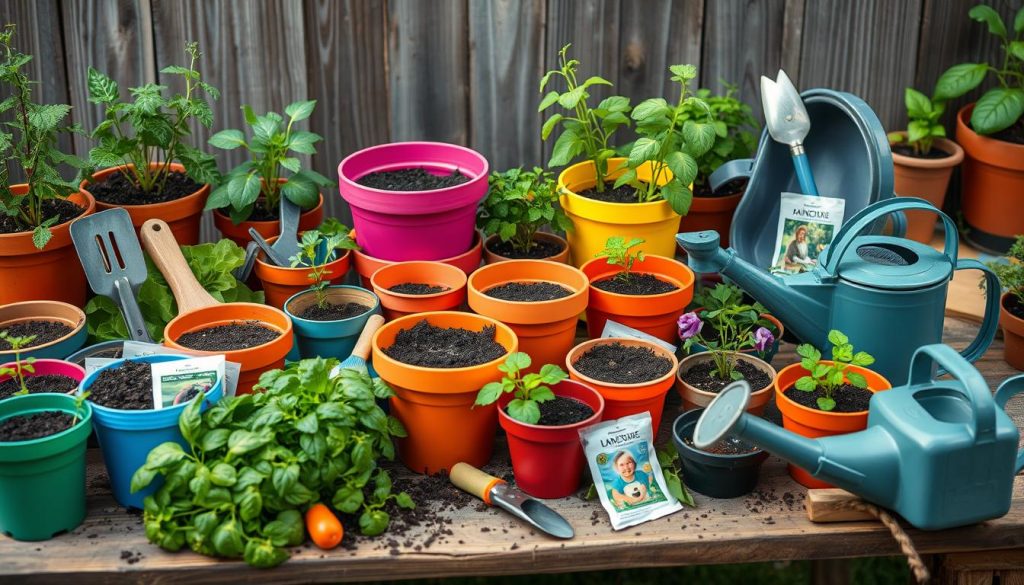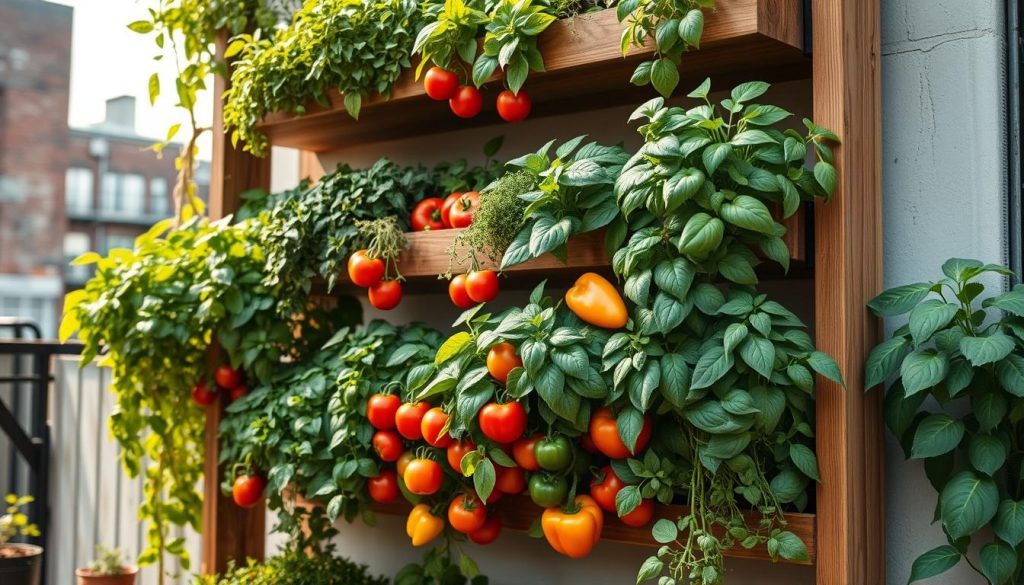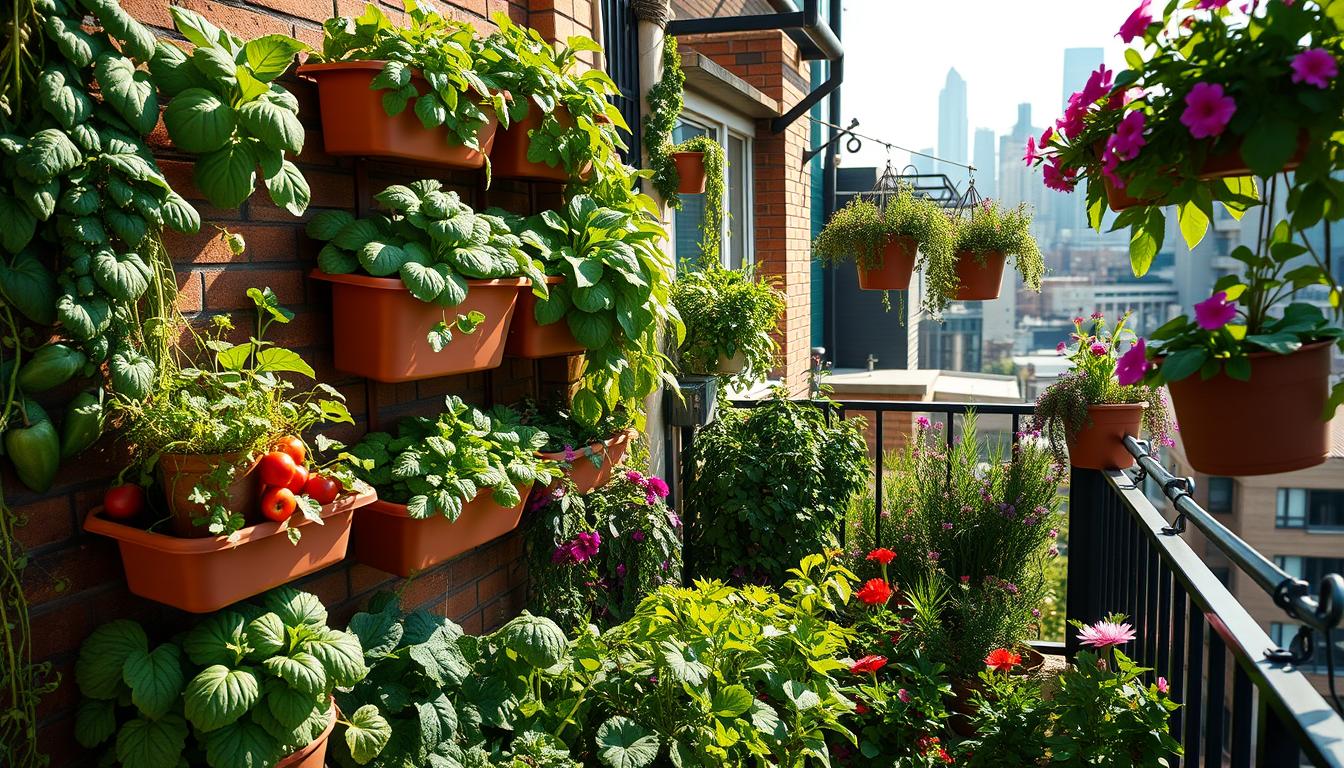Living in a small apartment or house with little outdoor space? You can still grow your own food! I’ll show you how to make the most of small spaces for gardening. I’ve turned tiny balconies and windowsills into mini-farms, and you can too.
In this guide, I’ll share my best tips for gardening in small spaces. We’ll look at smart ways to use every inch of your space. You’ll learn how to grow tasty veggies, herbs, and even flowers to eat. Soon, you’ll be enjoying fresh produce from your own urban garden, no matter how small your space is.
Understanding Small-Space Gardening
Small-space gardening is a big help for city folks and those with little outdoor room. Even the smallest balcony or windowsill can bloom with the right tricks. Let’s dive into what small-space gardening is and why it’s great.
What is Small-Space Gardening?
It’s about growing plants in tight spots with clever ideas. It’s all about using every inch wisely. Container and vertical gardening are top picks for me to save space.
Container gardening lets me grow plants in pots or boxes. Vertical gardening uses walls or trellises to grow up. These ways turn small spots into gardens.
Benefits of Growing Food in Limited Areas
There are many pluses to growing food in small areas. I’ve seen how it changes city living:
- Fresh produce right at my door
- Less money spent on food
- Less harm to the environment
- Better mental health
- Connecting with nature in the city
Vertical gardening lets me grow climbing veggies like peas and cucumbers. Container gardening is great for herbs and small tomatoes and peppers. The joy of picking my own food, no matter how little, is priceless.
| Method | Best For | Space Requirement |
|---|---|---|
| Container Gardening | Herbs, Dwarf Vegetables | Minimal |
| Vertical Gardening | Climbing Plants, Vines | Vertical Space |
Choosing the Right Plants for Small Spaces
Finding the right plants for your small garden is crucial. I’ve tried many and found some great ones for tight spots.
Best Vegetables for Small Gardens
Compact veggies are perfect for small gardens. Cherry tomatoes, dwarf peppers, and leafy greens like spinach and lettuce are great. They don’t take up much space but taste amazing.
Microgreens are also excellent. They grow fast and are packed with nutrients, all in a small space.

Herbs That Thrive in Containers
Herbs are ideal for small spaces. Basil, mint, thyme, and rosemary do well in pots. They’re easy to care for and add fresh taste to your food.
I love having a mini herb garden on my windowsill. It’s so convenient for cooking.
Edible Flowers to Consider
Edible flowers add beauty and flavor to your garden. Nasturtiums, pansies, and marigolds are my top picks. They grow well in containers and brighten up salads and desserts.
They also attract good bugs to your garden.
| Plant Type | Space Needed | Harvest Time |
|---|---|---|
| Cherry Tomatoes | 1-2 sq ft | 60-70 days |
| Microgreens | 1 sq ft tray | 7-14 days |
| Basil | 6-inch pot | 3-4 weeks |
| Nasturtiums | 8-inch pot | 35-52 days |
Container Gardening Essentials
Container gardening lets you grow food in small spaces. It’s versatile and rewarding, especially when space is limited. Let’s look at the key elements for success in container gardening.
Selecting the Right Containers
Choosing the right container is key. I look for pots with good drainage and enough depth for roots. For a high-tech option, hydroponic systems are great for small spaces.

Soil Choices for Container Gardens
The right soil mix is crucial for container plants. I use a lightweight, well-draining potting mix with compost. Raised bed gardening is also good, offering benefits of both containers and in-ground planting.
Watering Techniques for Success
Proper watering is essential in container gardening. I water deeply but less often to promote strong roots. Self-watering containers can also help keep plants moist.
| Container Type | Best For | Watering Frequency |
|---|---|---|
| Terra Cotta Pots | Herbs, Succulents | More Frequent |
| Plastic Containers | Vegetables, Flowers | Moderate |
| Self-Watering Planters | Thirsty Plants | Less Frequent |
| Hydroponic Systems | Leafy Greens, Herbs | Automated |
Vertical Gardening Solutions
Vertical gardening is a big help for growing food in small spaces. I’ll share tips for using it outdoors and indoors. You can bring fresh produce right into your home.
Vertical Planters and Stacking Systems
Vertical planters and stacking systems can really expand your growing area. I like using pocket planters on walls or fences for herbs and small veggies. Tiered planters are great for strawberries or lettuce.

Trellising for Climbing Plants
Trellising is great for climbing plants like peas, beans, and cucumbers. I use bamboo stakes to make a teepee for them. This lets me grow big veggies in small spots. For indoor gardening, a small trellis near a sunny window works well.
Creative Use of Walls and Fences
Walls and fences are perfect for vertical gardening. I’ve used hanging gutter gardens for herbs and salad greens. Old pallets make great vertical planters for succulents or trailing plants. Even old shoe organizers can become thriving herb gardens!
| Vertical Gardening Method | Best For | Space Saved |
|---|---|---|
| Pocket Planters | Herbs, Small Vegetables | 70-80% |
| Tiered Planters | Strawberries, Lettuce | 50-60% |
| Trellises | Peas, Beans, Cucumbers | 80-90% |
| Gutter Gardens | Herbs, Salad Greens | 60-70% |
Utilizing Garden Space Effectively
In urban gardening and small space farming, every inch counts. I’ve found clever ways to get the most out of tight spots. Let’s see how to make your small garden thrive.
Companion Planting Strategies
Companion planting changes the game in small spaces. Pairing plants can boost growth and keep pests away. For instance, basil near tomatoes tastes better and keeps flies off. Marigolds also keep pests at bay when spread around.
Interplanting Techniques for Maximizing Yield
Interplanting is my favorite way to grow more in less space. I plant radishes between carrots. By the time carrots need room, radishes are ready to pick. This trick doubles my harvest without needing more space.
| Technique | Benefits | Best For |
|---|---|---|
| Companion Planting | Pest control, improved growth | Tomatoes, basil, marigolds |
| Interplanting | Increased yield, space efficiency | Radishes, carrots, lettuce |
| Vertical Growing | Maximizes space, improves air circulation | Peas, beans, cucumbers |
Using these urban gardening tips, I’ve turned my small space into a productive haven. Creativity is key in small space farming. With smart planning, even the smallest garden can produce a lot.
Seasonal Considerations for Small Gardens
Growing food in small spaces needs smart planning. I’ll show you the best crops for balcony gardening and other small areas. Knowing what to plant when ensures fresh produce all year.
Cool-Season Crops That Do Well
Spring and fall are best for cool-season veggies. They love cooler temperatures and are ideal for small spaces:
- Lettuce
- Spinach
- Peas
- Kale
- Radishes
These grow fast and need little space, making them perfect for balconies. Plant them in early spring or late summer for the best results.

Warm-Season Crops for Small Spaces
Summer is great for sun-loving plants. Even in tight spots, you can grow these warm-season favorites:
- Cherry tomatoes
- Bell peppers
- Bush beans
- Compact eggplants
- Dwarf cucumbers
These plants love heat and sunlight. They’re perfect for balconies from late spring through summer. Choose compact varieties to make the most of your small space.
| Season | Crop | Days to Harvest | Space Needed |
|---|---|---|---|
| Cool | Lettuce | 45-55 | 6 inches apart |
| Cool | Spinach | 40-50 | 3-4 inches apart |
| Warm | Cherry Tomatoes | 60-70 | 1 plant per 5-gallon pot |
| Warm | Bell Peppers | 60-90 | 1 plant per 3-gallon pot |
Maintenance Tips for Small-Space Gardens
Keeping your small-space garden healthy needs regular care. I’ve found that proper maintenance is crucial for success. Here are some tips to keep your plants thriving.
Regular Care and Attention
Small gardens need daily checks. I water my plants often, adjusting based on weather and plant needs. Pruning helps manage growth in tight spaces.
I remove dead leaves and pinch back herbs to promote bushy growth. Fertilizing every few weeks keeps plants nourished in their limited soil.
Pest Management Strategies
Pests can quickly overwhelm small gardens. I check my plants regularly for signs of pests. When I find issues, I act quickly.
For container gardening, I use natural solutions like neem oil or insecticidal soap. These methods are safe for indoor gardening too. I also rotate my crops, even in small spaces. This prevents pest buildup and keeps the soil healthy.
| Common Pests | Natural Control Methods |
|---|---|
| Aphids | Spray with water, use ladybugs |
| Spider Mites | Increase humidity, neem oil spray |
| Fungus Gnats | Let soil dry, use sticky traps |
By following these maintenance tips, you’ll have a thriving small-space garden. Remember, consistent care leads to bountiful harvests in any garden size!
Sustaining Health in Small Gardens
Keeping your small garden healthy is key to success in urban gardening. I’ll share some organic practices and fertilizing tips that work wonders in tight spaces.
Organic Practices for Healthy Growth
In urban gardening, organic methods are your best friends. I use companion planting to naturally deter pests. Marigolds next to tomatoes keep bugs away. Basil near peppers improves their flavor.
Crop rotation is another great practice, even in raised bed gardening. I switch the spots of different plant families each season. This prevents soil depletion and reduces pest problems.
It’s easy to do in small spaces and keeps your garden thriving.
Fertilizing in Tight Spaces
Fertilizing is crucial in small gardens where plants compete for nutrients. I make compost tea for my urban garden. It’s a liquid fertilizer packed with nutrients.
Just steep compost in water for a few days, strain, and water your plants with it. It’s perfect for raised bed gardening where space is limited.
| Fertilizer Type | Benefits | Application |
|---|---|---|
| Compost Tea | Rich in nutrients, improves soil structure | Water plants weekly |
| Worm Castings | High in beneficial microbes, enhances plant growth | Mix into soil before planting |
| Fish Emulsion | Quick-acting nitrogen boost | Dilute and apply every 2-3 weeks |
Remember, a healthy garden starts with healthy soil. These organic practices and smart fertilizing techniques will help your small urban garden thrive, no matter how tight the space.
Harvesting and Enjoying Your Bounty
The best part of small-space gardening is picking and eating your homegrown goodies. I’m excited to share some tips on how to get the most out of your harvest. This includes both traditional containers and hydroponic systems.
Best Practices for Harvesting
Timing is key when it comes to harvesting. For leafy greens and microgreens, I snip them just above the soil line when they’re young and tender. With herbs, I pinch off the top leaves to encourage bushier growth. For vegetables, I pick them at their peak ripeness for the best flavor and nutrition.
Recipes to Make with Your Fresh Produce
Now, let’s talk about the fun part – eating! I love tossing fresh microgreens into salads for a nutrient boost. For a quick meal, I whip up a pasta dish with basil from my hydroponic system and cherry tomatoes from my container garden. The freshness of homegrown produce really shines in simple recipes that let their flavors take center stage.
Remember, small-space gardening is all about enjoying the process from seed to plate. So savor every bite of your hard-earned harvest!

